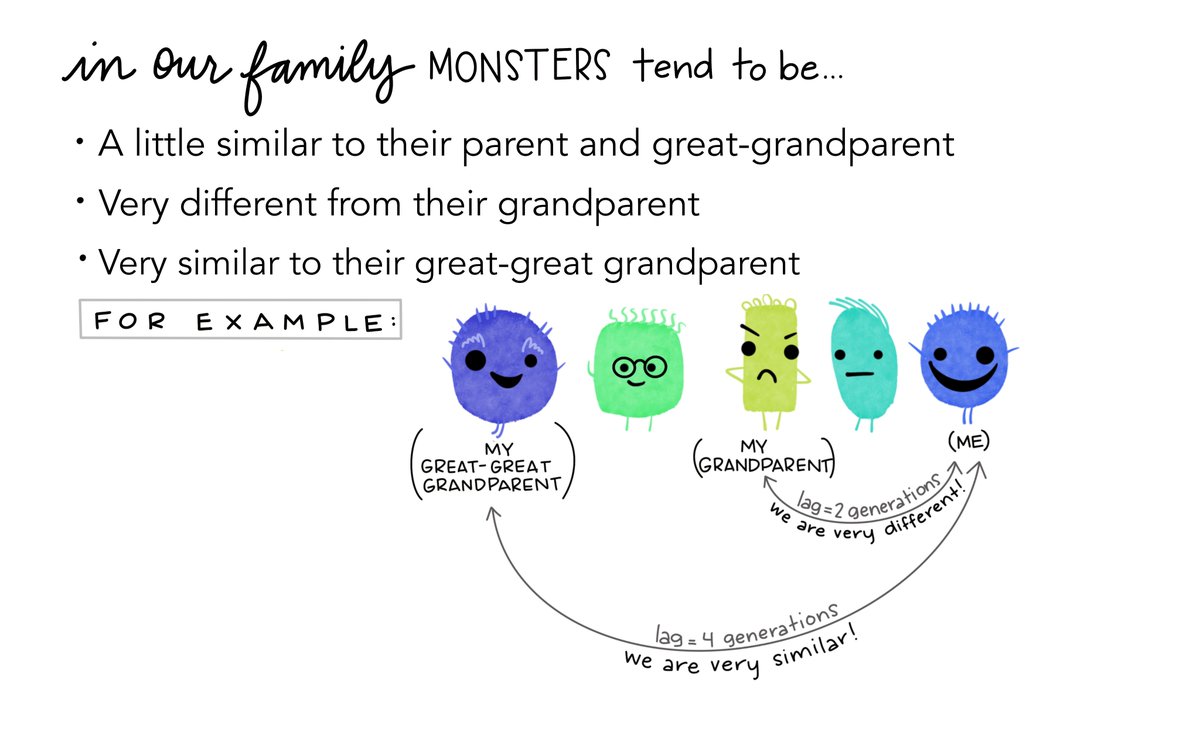A new series to introduce the autocorrelation function (ACF) w/ time series data, with special thanks to @robjhyndman for feedback & suggestions! 
 1/9: Meet the monster family. The youngest generation is on the right (that's our host).
1/9: Meet the monster family. The youngest generation is on the right (that's our host).

 1/9: Meet the monster family. The youngest generation is on the right (that's our host).
1/9: Meet the monster family. The youngest generation is on the right (that's our host).
 2/9: There are some notable patterns in similarities between monsters separated by different numbers of generations...for example, in this family, monsters tend to be very similar to their great-great grandparents, but very different from their grandparents...
2/9: There are some notable patterns in similarities between monsters separated by different numbers of generations...for example, in this family, monsters tend to be very similar to their great-great grandparents, but very different from their grandparents...
 3/9: Let's start with a blank graph area & start building the ACF by finding the correlation between monsters separated by different time lags (in our case, generations, shown on the x-axis).
3/9: Let's start with a blank graph area & start building the ACF by finding the correlation between monsters separated by different time lags (in our case, generations, shown on the x-axis).
 4/9: First find the correlation between each monster and it's parent (lag = 1 generation). They are slightly similar (the ACF is slightly positive).
4/9: First find the correlation between each monster and it's parent (lag = 1 generation). They are slightly similar (the ACF is slightly positive).
 5/9: Cool now do the same thing at lag = 2 (correlation between monsters & and their grandparent). They tend to be pretty different.
5/9: Cool now do the same thing at lag = 2 (correlation between monsters & and their grandparent). They tend to be pretty different.
 6/9: At lag = 3, we find the correlation between monsters and their *great grandparent*, and find a slight positive correlation.
6/9: At lag = 3, we find the correlation between monsters and their *great grandparent*, and find a slight positive correlation.
 7/9: Then we get to lag = 4, finding the correlation between monsters and their *great great grandparent* - in this family, they are highly positively correlated!
7/9: Then we get to lag = 4, finding the correlation between monsters and their *great great grandparent* - in this family, they are highly positively correlated!
 8/9: And we can continue finding correlations between each monster and those that came before them (e.g. with their great great great grandparent & beyond)!
8/9: And we can continue finding correlations between each monster and those that came before them (e.g. with their great great great grandparent & beyond)!
 9/9: In summary, the ACF shows us the correlation between observations (like monsters in my family) and those that came before them, separated by varied lags (here, monster generations).
9/9: In summary, the ACF shows us the correlation between observations (like monsters in my family) and those that came before them, separated by varied lags (here, monster generations). End.

 Read on Twitter
Read on Twitter










